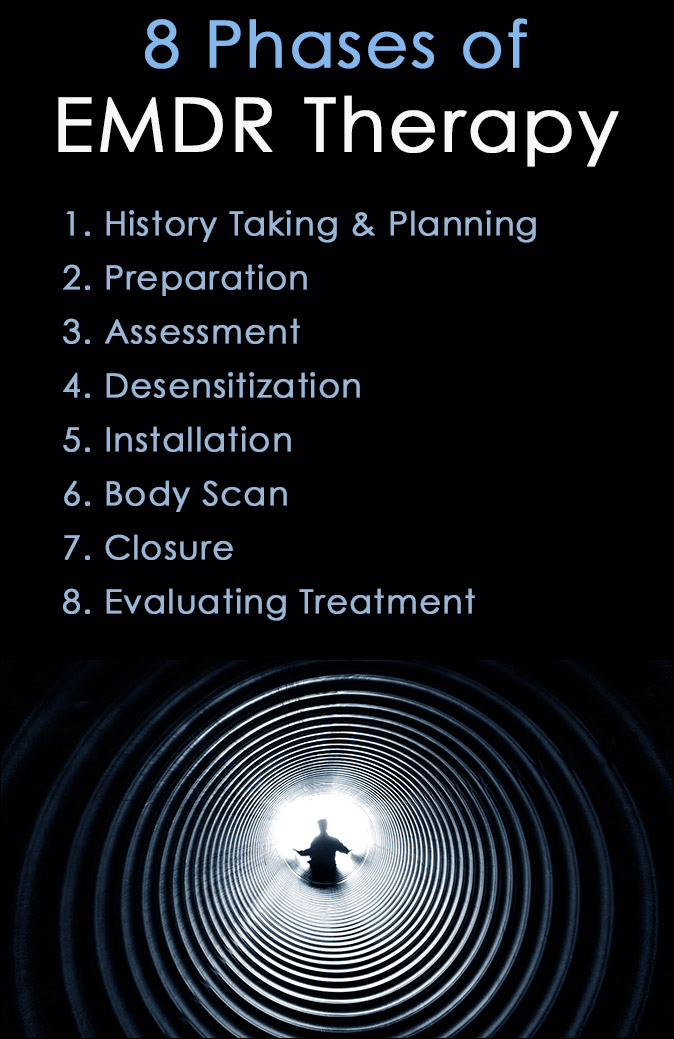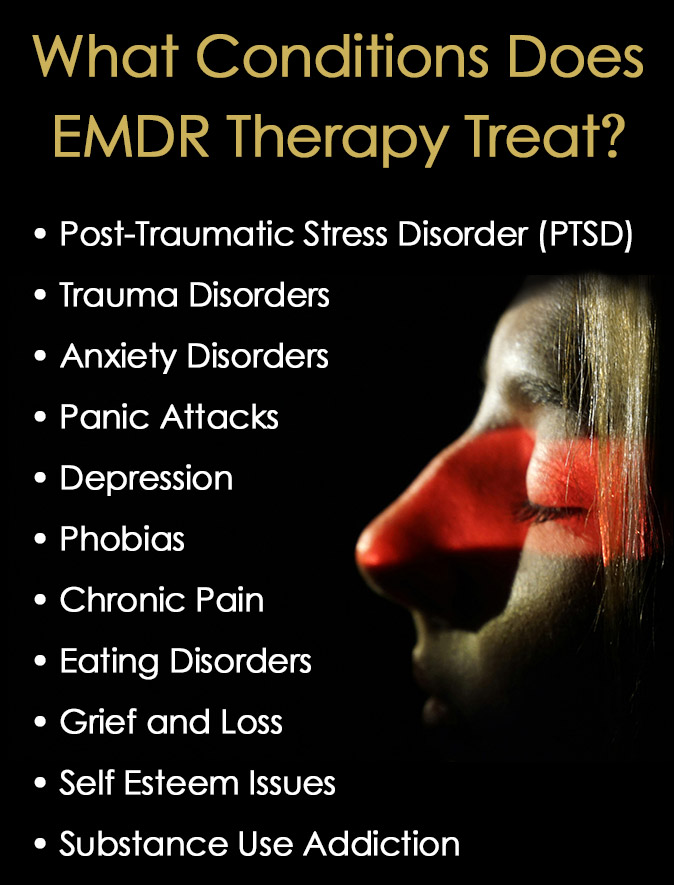
EMDR Therapy is a unique alternative to traditional psychotherapy treatment for PTSD, trauma, and other mental health conditions related to traumatic memories.
Formally known as Eye Movement Desensitization and Reprocessing, it is an evidence-based treatment method that is distinctly different from other therapies.
It is effective for healing and recovery when other therapies have failed to offer relief from the stuck memories of past traumatic events.
EMDR Therapy focuses on reprocessing stressful memories to overcome negative emotional states so patients move forward with a positive outlook on life again.
What is EMDR Therapy?
EMDR Therapy is an evidence-based treatment modality widely accepted for treating PTSD, past trauma, and other mental health issues.
It focuses directly on traumatic memories and a person’s emotional response to traumatic events to overcome the conscious or unconscious imagery, instead of describing the details of the event.
This differs from other forms of psychotherapy like CBT that aim to change or alter negative thoughts, emotions, and behaviors.
Trauma can cause gaps or disruptions in the way the brain processes past memories, and unprocessed memories often lead to psychological distress.
EMDR reintegrates and reprocesses these memories into a cohesive memory of the event that makes it possible for treating and healing the brain.
It is extremely beneficial for providing relief for PTSD and other trauma-related symptoms.
In his influential book about trauma healing, “The Body Keeps the Score,” Dr. Bessel van der Kolk considers EMDR as one of the most effective treatments for PTSD symptoms.
History of EMDR
Psychologist Francine Shapiro discovered the basic theory behind EMDR Therapy quite by accident in 1987.
She noticed that certain eye movements reduced the intensity and emotion of her own stressful thoughts and traumatic memories.
The experience led her to conduct research to study the effects of eye movement for treating stressful thoughts and traumatic memories. Further research studies demonstrated its effectiveness for treating trauma, PTSD, and other conditions.
Today, EMDR is recognized by the World Health Organization, the American Psychiatric Association, the Department of Veterans Affairs, and other health organizations around the world as an effective form of treatment for PTSD and trauma disorders.
How Does Eye Movement Desensitization and Reprocessing Work?
Researchers do not fully understand how EMDR Therapy works. It is believed that the treatment process causes the mental images of traumatic memories to be reprocessed or properly reorganized in the brain. This provides relief from the negative emotions and associations of a traumatic event.
During a typical session, an EMDR therapist asks the patient to focus on a traumatic memory that is causing distress while the therapist guides them through bilateral stimulation, usually in the form of eye movements.
Bilateral stimulation simply means stimulating both the left and right sides of the brain, and it can be achieved in various ways.
During EMDR Therapy, bilateral stimulation is applied as eye movements. The patient’s eyes follow the therapist’s finger back and forth from side to side while mentally focusing on the traumatic memory.
This produces a cognitive state in the brain similar to rapid eye movements during REM sleep and mimics the way the brain organizes memories while dreaming.
The EMDR therapy process follows 8 phases during treatment.

8 Phases of EMDR Therapy
1. History Taking and Planning
The first phase of EMDR Therapy assesses the patient’s history of trauma, difficulties related to the trauma, and identifies the traumatic events that require reprocessing.
2. Preparation
During the preparation phase, the therapist establishes trust and explains how the EMDR process works and the techniques to be used.
3. Assessment
The assessment phase allows the client to identify target memories to correct and the negative emotions associated with them.
4. Desensitization
The EMDR therapist guides the patient through bilateral stimulation eye movements while the patient focuses on the traumatic memory.
5. Installation
After desensitization, the therapist continues bilateral stimulation until the patient feels safe. The therapist then instructs the patient to hold that memory to strengthen positive beliefs about the traumatic memory.
6. Body Scan
The patient is asked to scan the body for any tension. If there are still some remaining negative residual effects, bilateral stimulation continues until they are relieved.
7. Closure
The session ends with closure when the patient achieves a state of calm and emotional stability.
8. Evaluating Treatment
At the beginning of follow-up sessions, the therapist reviews the patient’s progress from the previous sessions to determine if the treatment remains successful. If so, new traumatic memories are identified to target, and the process begins again.
What Conditions Does EMDR Therapy Treat?
EMDR therapy was originally developed to treat various types of PTSD and trauma disorders. It is now widely used for many mental health and psychological conditions.
Conditions Treated with EMDR Therapy include:
- Post-Traumatic Stress Disorder (PTSD)
- Trauma Disorders
- Anxiety Disorders
- Panic Attacks
- Depression
- Substance Use Addiction
- Phobias
- Chronic Pain
- Eating Disorders
- Grief and Loss
- Self Esteem Issues

PTSD and Trauma
EMDR Therapy is most effective for trauma and PTSD treatment because it directly focuses on targeting unprocessed traumatic memories. Reprocessing unhealthy memories significantly decreases PTSD symptoms, such as flashbacks and nightmares.
Anxiety and Depression
EMDR aims to reprocess past events and circumstances that cause anxiety and depression symptoms. Focusing on the stressful memories during EMDR sessions helps individuals get past the events and develop a healthier perspective.
Substance Use Addiction
Drugs and alcohol are often used to cope with the negative emotional effects of many mental health conditions. Eye Movement Desensitization and Reprocessing Therapy addresses the root causes and underlying conditions that prompted substance use. Many substance users benefit from the healing power of EMDR.
Other Conditions
Trauma plays a role in many other conditions such as eating disorders and dissociative disorders. The success of EMDR for healing trauma is also helpful for other conditions that are triggered by traumatic memories.
EMDR therapy helps the brain heal by reprocessing stressful memories and replacing them with positive ones, so individuals improve their mental well-being.
Frequently Asked Questions
What are the Benefits of EMDR Therapy Compared to Other Treatments for PTSD?
Compared to other treatments like Cognitive Behavioral Therapy, EMDR Therapy offers faster results in fewer sessions and does not require any homework like with CBT.
The patient does not need to provide detailed descriptions of the traumatic event with EMDR. It also directly engages traumatic memories in the brain through bilateral stimulation, which is why it is recognized around the world as an effective treatment for PTSD and other disorders.
How Long Does EMDR Therapy Typically Last?
Many EMDR therapy sessions last 60 to 90 minutes each, typically one or two times a week. The total number of sessions needed for recovery vary depending on the type and severity of the trauma, the number of traumatic memories targeted, and the presence of other mental health conditions.
Who is Not a Candidate for EMDR Therapy?
While EMDR can be very effective for treating PTSD and trauma, it probably won’t be effective for those who struggle with conditions that aren’t related to trauma. Individuals who experienced very recent traumatic events might need to establish more mental stability before beginning EMDR.
People with severe psychiatric conditions like schizophrenia, or some forms of bipolar or personality disorders may require specialized treatment that is better suited to their needs than EMDR Therapy.
Related Posts
- 5 Types of PTSD and Treatment for Post-Traumatic Stress
In the last several decades, it's become clear to health care experts that anyone can…
- June is PTSD Awareness Month
Because trauma impacts so many people, June is recognized every year as PTSD Awareness Month.…
- Complex PTSD Symptoms, Causes and CPTSD Treatment
Complex PTSD symptoms are closely related to those of post-traumatic stress disorder although there are…
